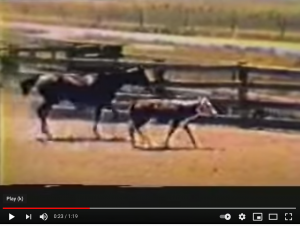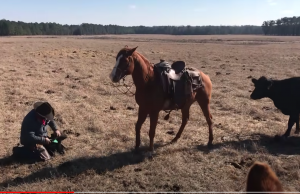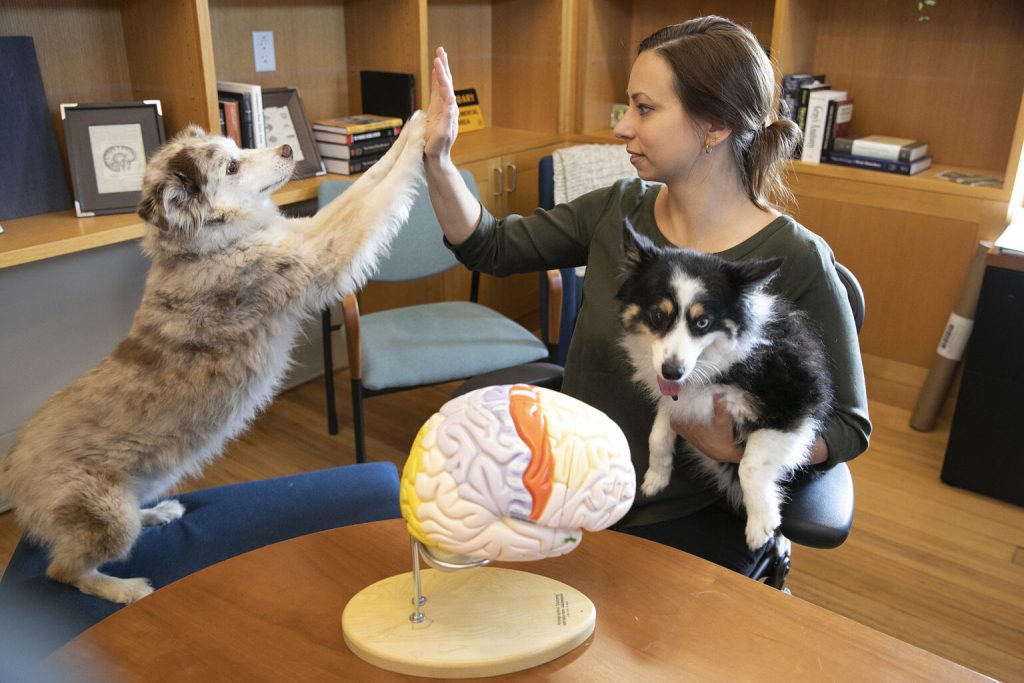
Horses may have the neurological mapping and make-up to complete certain tasks without a rider
This week, we visited with Dr. Erin Hecht, assistant professor in Harvard University’s Department of Human Evoluntionary Biology. Hecht’s research on dog brains and how breed can manifest in canine neuroanatomy got our attention here.
We talked with her via email of the possible insights we might gain for equine neuroanatomy.
Here are our questions and Hecht’s answers:
Cayuse asks:
Ranch horses are valued for their ability to move cattle quietly and react quickly to a changing environment, especially in response to cattle movement. Would you suspect that this trait is largely taught or largely in place neurologically speaking?
Here is a video that might help show you what these talented horses do, even without a rider:

This horse outmaneuvers the mother cow without instruction
And then there is this horse, who keeps a mother cow away without instruction as the rancher tags her calf.
Hecht:
This is a very interesting question which could be answered with research! Looking across the animal kingdom, some skilled behaviors are largely innate, with little learning required. One example of this would be web-making in spiders.
In other cases, skilled behaviors rely heavily on experience and learning during an individual’s lifetime. An example here would be language use by humans. But even in those cases, there are often innate biases that help facilitate learning – a predisposition to attend to certain aspects in the environment, or to be drawn to or to try to avoid particular situations.
In the case of human language learning, babies show early predispositions to attend to adults’ vocalizations and to babble, both of which probably help canalize their language learning along a productive path.
I would speculatively hypothesize that something similar might happen with ranch horses – some biases and predispositions are innate, and these shape individual animals’ learning experiences in a way that helps produce functional skill.
Cayuse asks:
Gaited horses naturally have different stride rhythms than non-gaited horses. For instance, a Tennessee Walker has a “running walk” that is completely different than, say, a trot or canter in a quarter horse. Can this be explained neurologically?

This Icelandic horse is tolting or performing a flying pace
This page highlights studies which cover the genetic aspect of gaitedness, considered a widespread genetic mutation.
Also, temperament is a big deal in the horse world. Even the span of breeds is from “cold blooded” to “warm blooded” Cold blooded are draft horses who are typically big, slow, and calm, while hot breeds like Arabians are more slight-framed and flighty. Would you suspect that their brains look very different, based on their temperaments?
Hecht: All behavior, including gait and other forms of locomotion, comes from the nervous system. So, if you have two different types of animals with different behavior, then there must be something different about their nervous system!
In the case of our 2019 dog study (which you wrote a post about), differences in brain anatomy were pronounced enough to be measured with MRI. But brain differences at a much finer anatomical level can also produce differences in behavior. For example, differences in the distribution of receptor types can alter the way that brain regions respond to different types of neurotransmitters. This can produce noticeable differences in behavior – like whether a species forms pair bonds or not, for example – but it would only be detectable by examining brain tissue at a microscopic level.
Read more about Hecht’s work here.
Follow Hecht’s work with Canine Brains here.
Photo below by Jon Chase, courtesy of Harvard Gazette. Read article here.

Dr. Erin Hecht and colleagues. Photo by Jon Chase
I observe wild horses in their natural environments. There is usually a predominant breed or type in an area. I loved your questions to Dr. Hecht, because they are similar to questions I often have when I am observing behaviors in the wild herds. For instance, when water resources are lower, we have observed wild horses herding cattle away from wells, they look much like the cutting horse in the video you shared! In this case, we know the horses are not trained, and many are not purebred quarter horses, although that is one of the breeds that they may have. Many of these horses also exhibit gaited traits, and will run with higher heads and cover quite a bit of ground at a nice fast trot rather than breaking into a gallop. I have also seen them treat antelope and elk like cows too, when there is competition for resources. SO how does a gaited horse naturally take to moving like a cow horse when pushing the competition off of a resource? Is that ability naturally in all horses? Did we just capitalize on it as we developed the quarter horse?
Something else that I wonder about. The sense of smell. How does it compare to a dogs? I know somebody in the PNW who is doing a study on the stud piles, what they mean. Horses will sniff them over, even moving pieces of manure to smell something underneath, much like dogs will smell a favorite post for “pee mail”. These are definitely used as communication but how is it being processed? These are the things I sit and wonder as I watch them.
I am new to your blogs, but I am loving them! Thank you!